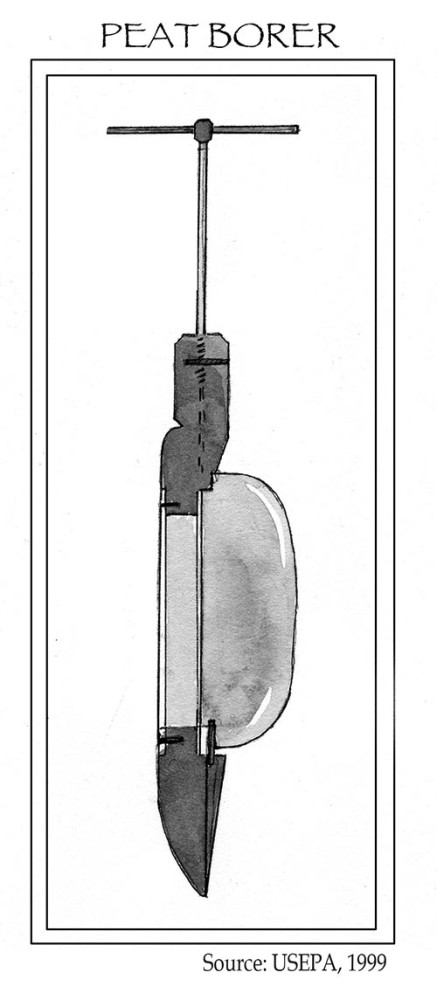
Gutter pipes full of soggy peat show up on the bench by my office each March. This means one thing: my colleague Peter Hope’s Saint Michael’s College students are about to experience time travel. You might reasonably ask how pipes filled with peat could possibly relate to time travel. What? No DeLorean, flux capacitor, or 1.21 gigawatts of electricity? To answer, we need to consider where peat comes from, and how it forms.
Peat accumulates in bogs over millennia. Decomposing plant material consumes oxygen, and sphagnum moss turns water acidic by pulling minerals from the water and releasing acid. When dead plants and moss pile up in acidic water with little oxygen, they remain more or less preserved. The resulting accumulation is called ‘peat.’
Pollen accumulates along with the peat, and that is where the time travel comes in. Pollen falls into two broad categories: the familiar sticky stuff carried by insects, and wind-blown pollen that makes us sneeze. Trees cast vast quantities of pollen on the wind and few grains hit their intended targets. Far more pollen blows around the landscape, and some of it ends up in bogs.
Two pollen grain traits make Hope’s time travel experiment possible: they have distinctive appearances that identify the type of plant each grain came from; and they are so resistant to decay that they last as long as the bogs in which they accumulate. At the top of the bog we find pollen from trees still growing today; as we go deeper, we travel back in time and learn what trees surrounded the bog in times past.
When less hardy people are comfortably indoors, Hope and his students drive long metal pipes into a Vermont bog. He told me that lightning is the only weather that would give him pause; handling tall metal pipes during electrical storms is ill advised.
The business end of his bog-coring device is like an apple corer. A trapdoor runs along its length. After driving the core down into the bog, a quick twist closes the trapdoor and the contained peat can be extracted like a cork from a bottle. After students remove the first peat core and safely stash it, they drive the coring device deeper into the same hole, further back in time.
With a dozen vertical feet of peat, students have traveled 12,000 years into the past, when woolly mammoths, mastodons, and saber-tooth cats were headed to extinction; all without the use of Doc Brown’s souped up sports car. The carefully labeled peat samples record the ghosts of forests past.
It will surprise few to learn that the pollen grains found close to the surface include spruce, hemlock, and pine: all trees common at lower elevations in the Champlain Valley. Things get more interesting as the students delve deeper.
About 20% of the pollen from deep in the bog came from balsam fir, a rare tree in today’s lowland Champlain Valley. To find much balsam fir today, you’d need to go uphill, quite a ways uphill. Elizabeth Thompson and Eric Sorenson’s Wetland Woodland Wildland: A Guide to the Natural Communities of Vermont, suggests seeking spruce-fir forests at elevations above 2,500 feet. Fir’s range has moved quite a distance from the 320 foot elevation of the bog our students visit.
Fir and other tree species continue to move. Research led by the University of Vermont’s Brian Beckage has chronicled tree movement over the last 40 years in the Green Mountains. In his study blocks, fir trees at lower elevations have declined, while seeds that fell above the species’ historic upper limits have germinated and flourished. There’s evidence that other tree species are also shifting their populations uphill. The changes in pollen our students observe send a clear message: forest composition has changed slowly but surely over time, and these changes correlate with changes in the climate. Brian Beckage’s recent work paints a picture of far more rapid change.
A few hours in lab is all it takes for Hope’s students to get a sense of what forest composition was like 12,000 years ago. During their lifetimes they will likely see additional changes and shifts in tree distributions that have already led to the redrawing of plant hardiness zones in our region.
These are essential lessons for all of us. Climate is changing rapidly, which affects forest composition. It will be up to us to determine how we will respond and adapt to these long-term changes.

